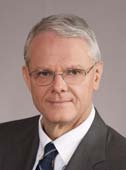The Department of Surgery
A new image

James Rutka
|
As part of our Strategic Plan for the Department of
Surgery, I was strongly encouraged by Dean Catharine
Whiteside to begin branding the Department in ways
which would enhance our visibility on the global stage,
increase our ranking on the continent, and promote
our ability for advancement across all of our Divisions.
In the process, I have learned that creating and promoting
a brand does not simply occur overnight. It takes a
concerted effort, and the passage of time, while attending
to our core values before this is accomplished.
One of the elements of initiating a new academic
brand is the creation of an image or logo which embodies the vision and mission
of the Department. When I took office in April 2011, I began to work
on a new image for the Department of Surgery. Most companies and organizations
have logos, but few have been able to convert those logos into meaningful
symbols. This is because most companies are not good at communicating
what they believe (1). Fortunately, I could draw upon previous times when
I fashioned logos to promote the organizations with which I was working.
These included the Division of Neurosurgery in the Department of Surgery,
the Arthur and Sonia Labatt Brain Tumour Research Centre, and the World
Academy of Neurological Surgery, to name a few.
I have been aided in the process by famed medical
illustrator Ian Suk, a graduate of the University of
Toronto's Biomedical Communications in 1993, who
is now the chief medical illustrator in the Department
of Neurosurgery at Johns Hopkins University. In my
opinion Ian is the most talented and acclaimed medical
illustrator in the world, and his works have adorned the
covers of numerous neurosurgical and medical journals
over the past 2 decades.
In creating a new image for the Department of Surgery,
I wanted to draw on our core values which are: 1) Surgery
in all of its facets including technical innovation, and education;
and 2) Science, given our rich history of accomplishments
amongst our faculty, and the emphasis we
have traditionally placed on our surgeon scientist training
program, which dates back to Dr William Gallie's tenure
as Chairman. Accordingly, it is my strong hope that we
have achieved this with the new image that has been created
with Ian Suk's help.
|
In the image depicted below, you will see two suture
needles that are slightly offset, one to the other, in space.
This idea came to me when I was glancing at suture packages,
and in particular, vascular suture materials in which
two suture needles are often connected by one suture
thread. Even in this age of advanced surgical techniques and
minimally invasive surgery, virtually all surgical specialties
are still using suture needles and sutures. And so, the suture
needles represent our emphasis and focus on the art and
practice of surgery. In this new image, the suture threads are
actually represented by a double helix of double stranded
deoxyribonucleic acid (DNA) with appropriate nucelotide
base pair cross - linking strands. The DNA represents our
focus on surgical science and includes our research work
from the molecule to man to community, in all of its forms.
As we created the logo in its final form, it did not
escape my notice that the colours of the DNA strands we
selected, red and blue, were connected by cross linking
bands that were white, making the logo highly reminiscent
of the colours of the archetypal "barber pole" from
antiquity where blue represented the veins, red represented
the arteries, and white was the background that
accentuated the spiral of the red and blue stripes.
The story of our new image is one that I hope will
resonate particularly well with all Divisions in the
Department of Surgery. In the near future, you will see
this image adorning our website, newsletters, letterhead,
periodicals, PowerPoint slide templates, awards, and certificates.
If any of you need a high resolution copy of this
new image in the Department of Surgery, please do not
hesitate to contact me.
James T Rutka, MD, PhD
RS McLaughlin Professor and Chair
(1) Sinek S, Start with Why. Penguin Group Publisher. Toronto,
Canada, page 161, 2009
|